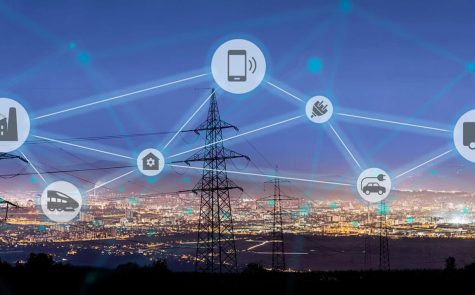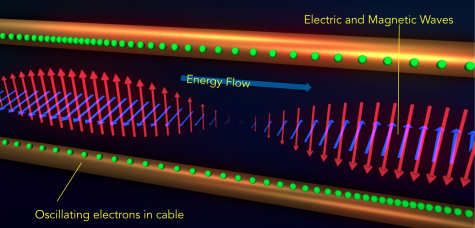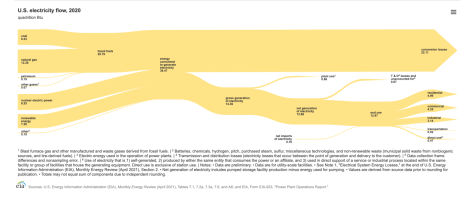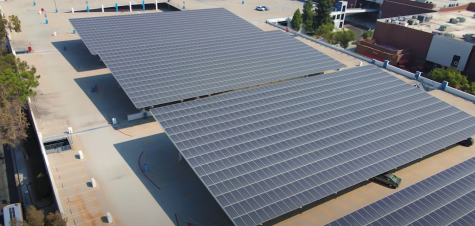Powering the World and Your Life
January 23, 2022
Electricity production is one of the biggest contributors to greenhouse gas emissions. While the public view of emitters contributing to climate change is overwhelmingly negative, electricity production has mostly been protected from criticism, given that it is the backbone of modern society, powering everything from machines, to entire households, to the internet. This resource has pushed humanity to where it is today, an industrial revolution that, arguably, is continuing. But what really is this vital phenomenon that powers the world? The simplest explanation is that electricity is the flow of electrons—a definition that barely explains what truly happens.

The purpose of electricity is to get energy from one place to another to power an object. Counterintuitively, it is not actually the flowing electrons that carry this energy, but the electromagnetic fields they generate; the electrons actually move relatively slowly. The flow of electrons causes electric and magnetic fields to be created, and it is through these fields that energy moves. By Scottish scientist James Clerk Maxwell’s law, anytime there are in-phase electric and magnetic fields, there is energy flowing perpendicular to both fields. In other words, the energy flows from a source to an endpoint through fields generated by electrons, not the electrons themselves.

Another misconception about electricity is that, in a circuit, energy is flowing directly inside and through the wires from the source to the endpoint. Since energy flows through the electromagnetic fields between the source and end, the wire length doesn’t matter (disregarding resistance). The time it takes for the energy to travel between source and endpoint depends on the distance between them, not the amount of wiring between them. Additionally, although the electrons in a circuit can flow forwards or backwards, the electromagnetic fields will always be pointing in the same direction, so the energy will only flow away from the source. This is how power lines transfer energy from power plants to homes.
Power lines have transformers that continuously reverse the current, alternating current (AC), causing the flow of electrons to oscillate back and forth but for the direction of electromagnetic waves to never change—the fields are always aligned in the same direction. Because this creates an uninterrupted flow of energy across large distances, power plants don’t have to be right next to the things they power. But a basic question remains: Where does the electricity come from?

Although energy is most useful to humans in the form of electricity, it is almost never found in that form in nature. Converting energy sources to electricity has an extremely high cost, with about 60% of the energy used to produce electricity being lost in the conversion process as thermal energy, or heat.
 This conversion rate is especially inefficient in fossil fuels, which must first be burned to boil water to create steam that then turns electricity-producing turbines. Even though fossil fuels are largely inefficient, in 2019, they actually accounted for 56% of the world’s electricity production, according to the U.S. Energy Information Administration. Despite their drawbacks, due to their availability, they are the most dominant form of energy used today.
This conversion rate is especially inefficient in fossil fuels, which must first be burned to boil water to create steam that then turns electricity-producing turbines. Even though fossil fuels are largely inefficient, in 2019, they actually accounted for 56% of the world’s electricity production, according to the U.S. Energy Information Administration. Despite their drawbacks, due to their availability, they are the most dominant form of energy used today.
In comparison, however, renewable energies have significantly higher conversion rates, and nuclear power has a better electricity produced to resource consumed ratio. The flow of wind and water directly turns turbines that produce electricity, meaning that there is no conversion to thermal energy, and thus less energy wasted. Additionally, well-made solar panels are extremely efficient, as photons from the sun directly excite electrons in the panels. This causes them to move, which creates current and flow of energy: electricity. Because renewable energies are so much more efficient than fossil fuels when converted into electricity, using them would actually result in a tremendous reduction in the amount of energy needed to power the world—less energy would be wasted as heat. Nuclear power relies on uranium rods, but much more electricity can be produced per ton of uranium than ton of coal, a fossil fuel.
Fossil fuels are some of the least effective methods of electricity generation, and create many unwanted byproducts during their burning. Investing in renewable energy—particularly solar energy—would be a better option due to their efficiency. Typically, solar farms generate about 1 megawatt of energy per 4 acres of panels, meaning that it would take about 8 million acres to completely satisfy the electricity needs of the U.S per day. This may seem like a lot, but the U.S. contains 2.43 billion acres of land, so solar panels would only account for 3.3% of U.S. land.
In contrast, production of fossil fuels in the U.S. already takes up 36 million acres of land: over four times the amount of land solar energy would need. Using solar panels on that land could eliminate carbon dioxide emissions while maintaining energy production levels.

Solar panels could also be installed in many more places, such as rooftops, parking garages, and in deserts, so they could be integrated without “wasting” land. Once solar infrastructure is in place, it lasts essentially forever; the biggest costs are their implementation, which would eventually be offset by the electricity that the panels generate. It is just a game of patience: The sun bathes the earth in more energy each year than all the fossil fuels in the world combined will ever produce. If the proper steps were taken to use this energy, electricity could become a cheap and 100% renewable resource—a thought worth considering.



















